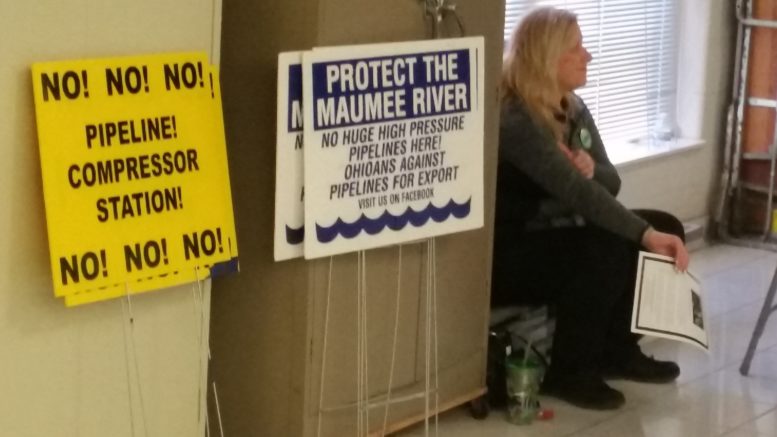By JAN LARSON McLAUGHLIN
BG Independent News
Nexus pipeline has been granted federal approval to be constructed across Ohio – but local officials and activists still aren’t giving up their hopes to get the route changed.
Late on Friday, the Federal Energy Regulatory Commission approved the construction of the 36-inch high-pressure pipeline to carry natural gas from shale fields in Appalachia across northern Ohio and into Michigan and Ontario, Canada.
The $2 billion Nexus pipeline, stretching 255 miles, will be capable of carrying 1.5 billion feet of gas per day.
But Bowling Green officials and local activists have expressed concerns about the close proximity of the proposed pipeline to the city’s water reservoir next to the Maumee River.
Bowling Green Mayor Dick Edwards, who has been asking the Ohio EPA to consider the risks to the city water treatment plant, still hopes the state agency can intervene.
“It still has to be certified by the Ohio EPA,” Edwards said Sunday afternoon. City officials are scheduled to have a conference call with Ohio EPA Director Craig Butler and his staff next week. The agency has promised the mayor that they are conducting a systematic review of concerns submitted by Bowling Green officials.
“They are painfully aware of what has happened with the Rover pipeline” in other areas of Ohio where hazardous material spills have occurred, Edwards said.
The mayor insisted that the Nexus plans are not final.
“We’ve tried to protect the interest of Bowling Green as it relates to the water treatment plant,” with the pipeline proposed to be buried 700 feet away. “I’ve always said that was not a good location.”
Edwards said the city has invested more than $10 million in the water treatment plant that now serves a large portion of Wood County and the city of Waterville.
“The probability of something happening is on the low side,” the mayor said. However, studies raise questions about the pipeline going under the Maumee River and the Bowling Green Fault, so close to the plant.
“It’s the absurdity of it all to have it so close to the water treatment plant,” Edwards said. “There are these questions that are still looming.”
The mayor is counting on the Ohio EPA to thoroughly review the information submitted about local concerns.
“I’m just trying to build a case – on analytical data, not emotion – in the event, heaven forbid, that something goes haywire with this project.” The city will then have means of recourse to levy fines and assess damage, Edwards said. “We’re just trying to build a case.”
But activist Lisa Kochheiser does not have the same confidence in the Ohio EPA to listen to local concerns. Both she and the mayor noted that FERC acted very quickly on the Nexus proposal once President Donald Trump had appointed enough commission members to take action.
“I knew that Nexus would be at the top of their list,” Kochheiser said Sunday. “They did give their rubber stamp to the project.”
Kochheiser said Nexus still needs a water permit from the Ohio EPA before construction can begin – but she isn’t expecting that to take long.
“I have a suspicion they are ready to put the drill bit in by the water plant tomorrow,” she said, noting that Nexus pipeline officials have not acknowledged any threats the line may create going under the Maumee River.
“They will be very anxious to get going on that,” Kochheiser said.
There is a “slight chance” that the Ohio EPA will order the pipeline route to change, she said. “It would be nothing short of a miracle,” Kochheiser said. “It’s not likely they will deny the permit.”
Kochheiser said local efforts will continue to get a charter amendment on the Bowling Green ballot that will allow people to legally protest pipeline construction.
“We’re still going to be putting pressure on the board of elections to put the charter amendment on the ballot,” she said.
A letter from the petition organizers was sent to the Wood County Board of Elections on Friday, asking that the board not delay in getting an answer from the county prosecutor’s office about whether or not the charter amendment can appear on the November ballot.
The charter amendment, according to Kochheiser, would allow people to protest the pipeline without the threat of winding up in jail.
“The oil and gas industry doesn’t want anything in their way – including human beings,” she said.
In a news release on Friday, Nexus said it would give an updated 2018 in-service date after reviewing its construction plans and FERC’s decision. DTE Energy estimated last month it would take seven to 10 months to build the pipeline once FERC approved the project.
“We are very pleased to reach this significant milestone and move one step closer to construction of the pipeline, which will diversify the region’s energy sources and generate significant economic benefits for local communities,” the news release said.





